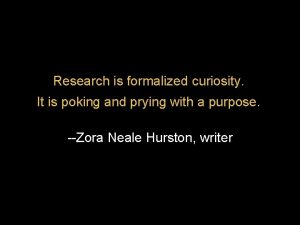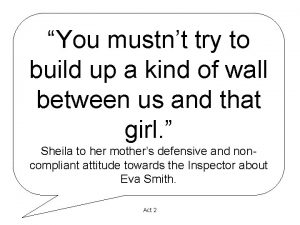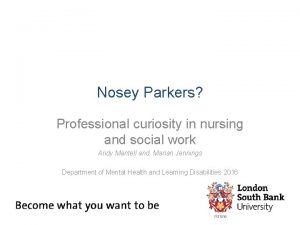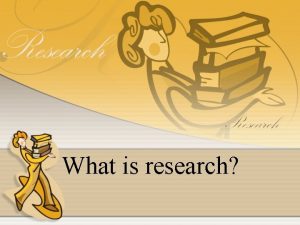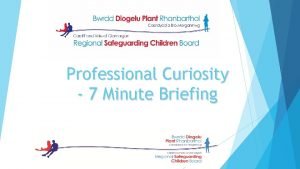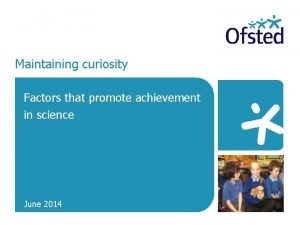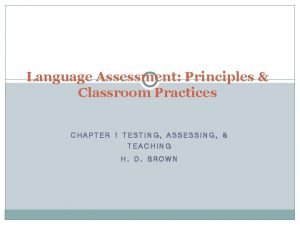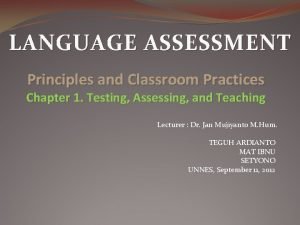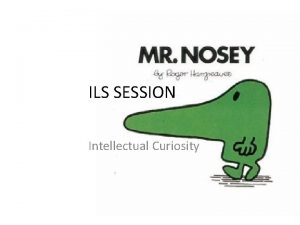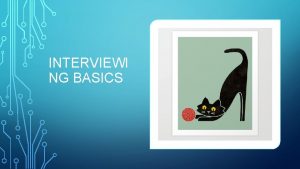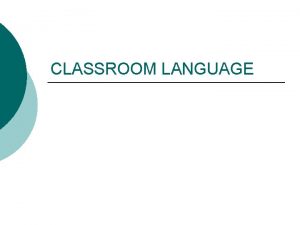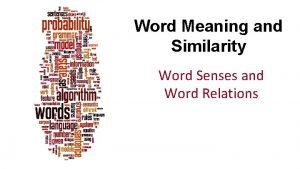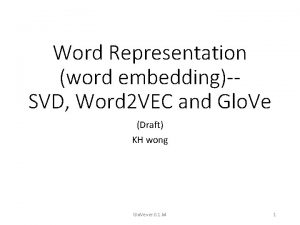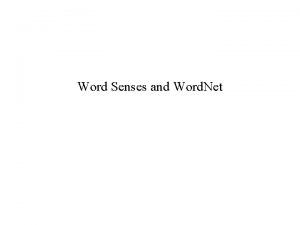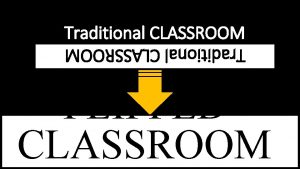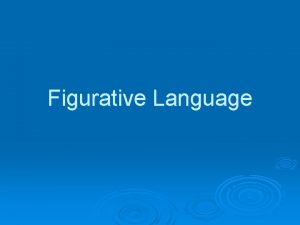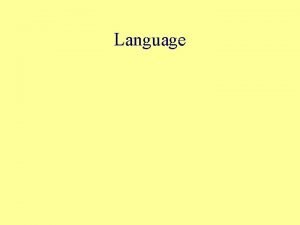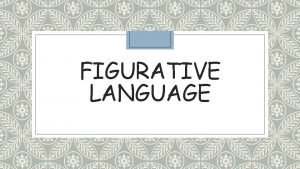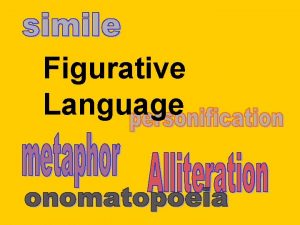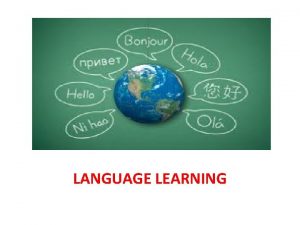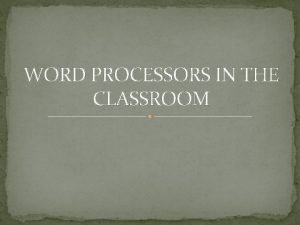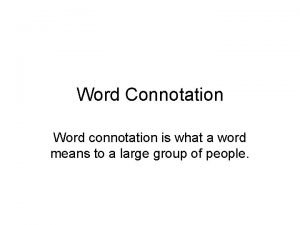CURIOSITY AND LANGUAGE IN THE CLASSROOM WORD OF








































- Slides: 40

CURIOSITY AND LANGUAGE IN THE CLASSROOM

WORD OF THE DAY

Ø What are some ways that we model curiosity about language in our daily classroom practice? Ø How can we get students to experiment with language and expand their vocabulary? Ø How do we get more subtlety and specificity in their articulation of responses?

Ø How do we get students to retain and remember metalanguage? Ø Is it worth testing the terms? Ø What are some fun ways of reviewing and revisiting vocabulary?

NEVER BEING CERTAIN Dear students, I have marked your essays. You used a range of techniques to evoke certain responses from me. I felt many different emotions reading them and you have made me think about so many different things in so many ways. Warm regards, Mrs Daly

What’s got your goat? What bugbears do you find frustrating in the classroom?


What are some ways that we model curiosity about language in our daily classroom practice?

WAYS OF WONDER ØWord of the day ØResponding words ØGlossary lists/terms ØTesting terms ØBest in context ØPlayfulness and nuance


CURIOUS CLASSROOM CAPERS

What are some ways that we model curiosity about language in our daily classroom practice?


How do we get more subtlety and specificity in their articulation of responses?


BEYOND SAD, MAD AND BAD: ARTICULATING OUR RESPONSE TO TEXTS POSITIVE CONNOTATIONS Empowered Uplifted Inspired Enlightened Engaged Hopeful Optimistic Liberated Heart-warmed Impressed Endeared (feel fondly about something or someone) Awed Heartened Overjoyed Enamoured Reassured NEGATIVE CONNOTATIONS Dismayed Harrowed Disheartened Appalled Concerned Alarmed Unsettled Exasperrated Infuriated Disgusted Violated Angered Outraged Depressed Demoralised Dumbfounded Incredulous Distressed Uncomfortable Guilty Exploited Provoked Sombre NEUTRAL Reflection Conflicted Enlightened Ambivalent (feeling conflicted) Destabilised Contemplative Meditative Aware Reflective Informed Educated Convinced Sobered

Write a brief paragraph describing your response to Osama. You should cover how it makes you feel, any values it appealed to and ideas it raises. Osama follows the plight of a young girl’s struggles as she endures the oppression of the Taliban and her attempt to mask her identity as a female to avoid as much injustice as possible. The documentary left me feeling harrowed and mortified at the exploitation and mistreatment of the protagonist, Osama. One scene that I found particularly disturbing was the film’s resolution leaving the viewer with the implication of rape and lack of hope for her life. Another unsettling scene is the imprisonment of Osama behind bars, and the symbolic motif of her skipping with a rope signifying that she is clinging to what is left of her innocence and childhood. The documentary appeals to the viewers’ values of childhood, freedom and equality and we are left infuriated at the overt discrimination of women, political exploitation of power in the Taliban and religious fundamentalism. The hypocritical way their interpret laws for their own purposes, disgusted the viewers.

NEGATIVE NANCY The author presents a negative view on pageants/The author suggests pageants are good POSITIVE Praising Affirming Effusive Endorsing Glowing Glorifying Praiseworthy Approving Lauding (to praise someone/something) Accepting Advantages Supporting Celebratory Encouraging Enlightening Impressive Good Helpful Benefits/beneficial Merits NEGATIVE Attacking Polemical Inflammatory Incendiary Pessimistic Aggressive Alarmed Judgmental Disapproving Hypocritical Critical Scathing Harsh Unforgiving Unaccepting Unrealistic Condemnatory Detrimental Damaging Abrasive Perils/dangers

THE GOOD, THE BAD, AND THE UGLY GOOD BAD UGLY Beneficial Benefits Positive(s) Flattering Laudable Optimistic Merits Attributes Advantageous Meritorious Detrimental Insidious Appalling Abysmal Woeful Detrimental Harmful Destructive Damaging Downsides Critical Egregious Ill Good Bad Positive Negative


How do we get more subtlety and specificity in their articulation of responses?

How can we get students to experiment with language and expand their vocabulary?


WORDS FOR WALKING

WORDS FOR WALKING Stalk Prance Introduce your character, using three sentences to describe their gait and style of walking. Stomp Lumber Sidle Saunter Shimmy Mince Sashay Galumph From your description, show don’t tell their age, mood and emotional state


VOICE CHARACTER SITUATION Singsong An enthusiastic kindergarten teacher Asking students to pay attention during story time Rough A skinhead Asking someone for directions at the station Brittle A lady at a checkout Someone has asked her how her day is

VOICE CHARACTER SITUATION Singsong An enthusiastic kindergarten teacher Asking students to pay attention during storytime Rough A skinhead Asking someone for directions at the station Brittle A lady at a checkout Someone has asked her how her day is

A THOUGHTFUL THESIS Explores Protagonist Griet Class Journey Male gaze Humble origins Bourgeois background Coming of age Jealousy Maturation Catholicism Conflict Gender Bildungsroman Modesty Journey Motif Symbolism Point of view Navigate Artistic appreciation Enigmatic Dutch Golden Age Vermeer Follow Catharina Conflicting worlds

How can we get students to experiment with language and expand their vocabulary?

How do we get students to retain and remember metalanguage?

GETTING BETTER META v. Terminology lists v. Testing on terms v. Getting to know your glossary v. A series of sentences: Model tricky terms in action v. Jennie’s wordsleuths

MISE-EN-SCENE (BEST IN CONTEXT) The mise-en-scene of the Medicine Sans Frontier image works to direct the audience of _______ to consider the important issue of ______. In particular, the gaze of the figures helps to illustrate ______. The woman is looking _______ which evokes a sense of _____________. The child’s gaze is ________, engendering a sense of ________ in the audience.

TESTING TERMS Section One: Persuasive Terminology (7 marks) Define the following terms: EMOTIVE LANGUAGE (1 mark) __________________________________________________________________ ANECDOTE (1 mark) __________________________________________________________________ APPEALS (1 mark) __________________________________________________________________ METAPHOR (1 mark) __________________________________________________________________ JUXTAPOSITION (1 mark) __________________________________________________________________ Identify a language technique used in one of the following phrases: The scorching sun baked the back of my neck = …………… (1 mark) The black hole of endless, unimportant streams of technology-enabled information is devouring everyone living in the 21 st century. = …………… (1 mark)


Definitions and critical vocabulary Cultural identity Cultural myths Representative Egalitarian Marginalisation Multicultural Eurocentric Contested Multifaceted Stereotypes Diverse Multifaceted Nebulous Evolving Homogenous Monocultural Quintessential Values Attitudes Traditions Patriarchal Divisive Cultural cringe Irreverent Representation Larrikinism Perspectives Anti-authority Dynamic Romanticised Complex Destabilise Heterogeneous Interrogate Iconography

Year 12 ATAR English Terminology Write in the correct term next to its definition Perspective identity context Voice attitudes Point of view Term representation values modes Definition a position from which something may be viewed or considered. It refers to the way in which readers are positioned through the text, or how a particular ideology is embedded in a text. The various processes of communication: listening, speaking, reading/viewing and writing/creating. They are also used to refer to the semiotic (meaning-making) resources associated with these communicative processes, such as sound, print, image and gesture. refers to the way people, events, issues or subjects are presented in a text. The term implies that texts are not mirrors of the real world; they are constructions of ‘reality’. These constructions are partially shaped through the writer’s use of conventions and techniques. who a person is, how people recognize themselves The opinion or viewpoint expressed by an individual in a text, for example, an author, a narrator, a character or an implied reader. The environment in which a text is responded to or created. outlooks or specific feelings about something can be used to refer to the nature of the voice projected in a text Of the author In the literary sense, this term can be used to refer to the nature of the voice projected in a text by an author; the persona, role or character adopted by an author. Of the narrative The ways in which a narrator may be related to the story. For example, the narrator might take the role of first or third person, omniscient or restricted in knowledge of events, reliable or unreliable in interpreting what happens. these underlie our attitudes. They are what we hold to be important and are promoted in texts.

How do we get students to retain and remember metalanguage?

What are some fun ways of reviewing and revisiting vocabulary?

 Curiosity and the copycat
Curiosity and the copycat Cse smart class
Cse smart class A piece of gross impertinence
A piece of gross impertinence Professional curiosity in nursing
Professional curiosity in nursing Intellectual curiosity definition
Intellectual curiosity definition Research is formalized curiosity
Research is formalized curiosity Natural curiosity
Natural curiosity Curiosity
Curiosity Professional curiosity 7 minute briefing
Professional curiosity 7 minute briefing Robot curiosity funzioni
Robot curiosity funzioni Maintaining curiosity
Maintaining curiosity Language assessment: principles and classroom practices
Language assessment: principles and classroom practices Language assessment: principles and classroom practices
Language assessment: principles and classroom practices Hình ảnh bộ gõ cơ thể búng tay
Hình ảnh bộ gõ cơ thể búng tay Frameset trong html5
Frameset trong html5 Bổ thể
Bổ thể Tỉ lệ cơ thể trẻ em
Tỉ lệ cơ thể trẻ em Chó sói
Chó sói Tư thế worms-breton
Tư thế worms-breton Hát lên người ơi alleluia
Hát lên người ơi alleluia Môn thể thao bắt đầu bằng chữ đua
Môn thể thao bắt đầu bằng chữ đua Thế nào là hệ số cao nhất
Thế nào là hệ số cao nhất Các châu lục và đại dương trên thế giới
Các châu lục và đại dương trên thế giới Công thức tính thế năng
Công thức tính thế năng Trời xanh đây là của chúng ta thể thơ
Trời xanh đây là của chúng ta thể thơ Mật thư tọa độ 5x5
Mật thư tọa độ 5x5 Phép trừ bù
Phép trừ bù Phản ứng thế ankan
Phản ứng thế ankan Các châu lục và đại dương trên thế giới
Các châu lục và đại dương trên thế giới Thể thơ truyền thống
Thể thơ truyền thống Quá trình desamine hóa có thể tạo ra
Quá trình desamine hóa có thể tạo ra Một số thể thơ truyền thống
Một số thể thơ truyền thống Bàn tay mà dây bẩn
Bàn tay mà dây bẩn Vẽ hình chiếu vuông góc của vật thể sau
Vẽ hình chiếu vuông góc của vật thể sau Biện pháp chống mỏi cơ
Biện pháp chống mỏi cơ đặc điểm cơ thể của người tối cổ
đặc điểm cơ thể của người tối cổ Thế nào là giọng cùng tên? *
Thế nào là giọng cùng tên? * Vẽ hình chiếu đứng bằng cạnh của vật thể
Vẽ hình chiếu đứng bằng cạnh của vật thể Fecboak
Fecboak Thẻ vin
Thẻ vin đại từ thay thế
đại từ thay thế
